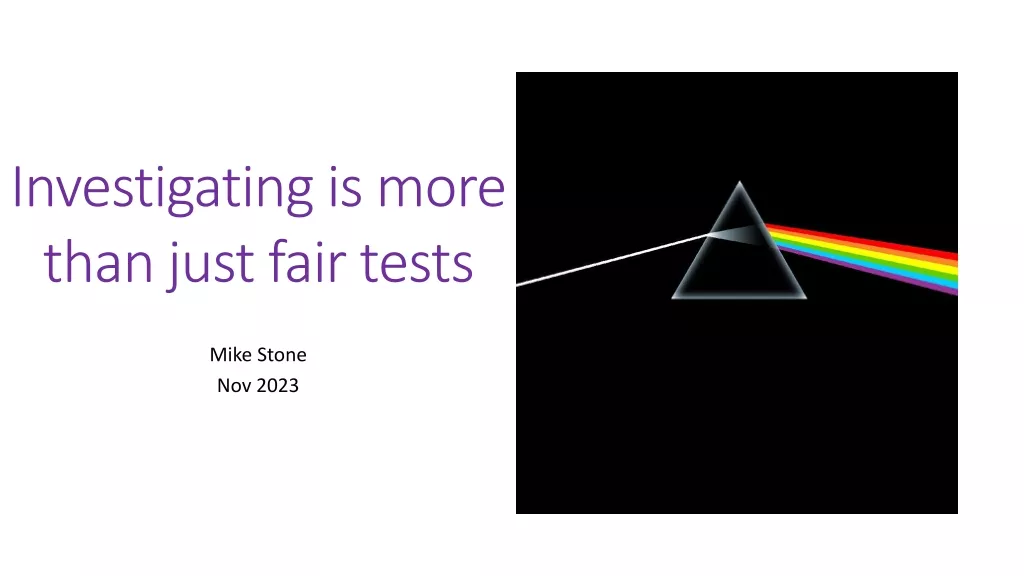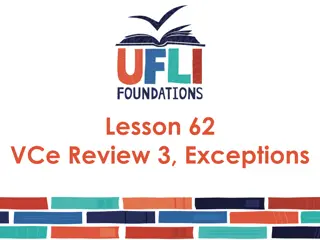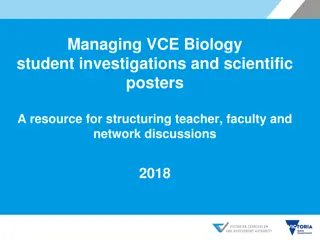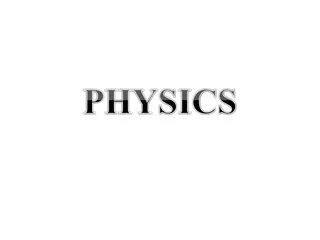Effective Strategies for Managing VCE Physics Student Investigations and Scientific Posters
Explore resources and best practices for structuring VCE Physics investigations and scientific posters. Covering topics from poster requirements to evaluating student work, this guide aims to enhance teaching effectiveness and student learning outcomes in Units 3 and 4.
Download Presentation

Please find below an Image/Link to download the presentation.
The content on the website is provided AS IS for your information and personal use only. It may not be sold, licensed, or shared on other websites without obtaining consent from the author.If you encounter any issues during the download, it is possible that the publisher has removed the file from their server.
You are allowed to download the files provided on this website for personal or commercial use, subject to the condition that they are used lawfully. All files are the property of their respective owners.
The content on the website is provided AS IS for your information and personal use only. It may not be sold, licensed, or shared on other websites without obtaining consent from the author.
E N D
Presentation Transcript
Managing VCE Physics student investigations and scientific posters A resource for structuring teacher, faculty and network discussions August 2018
Resource Outline Section A: Scientific posters Section B: Student investigation topics in Units 3 and 4 Section C: Approaches to running investigations Section D: Managing student-designed practical investigations across Units 3 and 4 Section E: Laboratory usage Section F: Putting it all together
Section A Scientific posters
Scientific poster Units 3 and 4 VCAA template For Units 3 and 4, students scientific posters must include the following seven sections: - Title - Introduction - Methodology - Results - Discussion - Conclusion - Acknowledgments and references Word limit is 1000 words Notes: The VCAA template referred to in the listed assessment tasks for Unit 4 Outcome 3 refers to seven sections listed on the left side of this slide Physical templates, including digital poster template layouts, are readily available, free of charge, on the Internet
Scientific poster Units 1 and 2 Unlike the scientific poster requirements for Units 3 and 4, teachers of Units 1 and 2 may choose to: change word limits (for example, decrease) provide greater scaffolding of the poster allow students to produce the poster as a group assignment/assessment task assess the poster as a group assignment/ assessment task. Discuss: How can poster sections be scaffolded such that there is a balance between providing support for students whilst enabling students to be differentiated, particularly at the top end ?
Evaluating scientific posters Prior to beginning work on constructing a scientific poster, it is useful to unpack the strengths and weaknesses of de-identified student work from previous years and/or scientific posters accessed on the Internet Display a selection of 10-20 posters around the classroom Students work in pairs or threes and use three different coloured post it notes representing strengths , limitations and suggestions for improvement to evaluate a poster Student groups then move around the room to evaluate remaining posters, overlapping similar comments provided by earlier groups Teacher leads a discussion to compare ideas and to summarise elements of effective science communication Discuss: Is this activity worthwhile undertaking for Units 1 and 2 as well as for Units 3 and 4?
Scientific posters: Succinct communication of science Issues with student posters typically include: poster title not worded as a question including data tables (unnecessary) as well graphs inappropriate graph scaling, axes and labelling small font size not easily read too wordy lack of graphics/illustrations/flowcharts to balance words inclusion of unnecessary information Further advice about the construction of scientific posters can be found in the Advice for Teachers on the VCAA website
Discussion: Science communication The most common problem for students when constructing their scientific posters is exceeding the word limit and having a high word/graphic ratio Discuss: What strategies can be used to assist students to communicate science ideas more succinctly? Which graphic types require explicit teaching as representations of science understanding and skills?
Poster logistics No drafts In Units 1 and 2, a scientific poster may be based on research (library/secondary sources) or primary research In Unit 3 or 4, or across Units 3 and 4, the poster: - must involve collection of primary data - must include seven sections of poster template, with acknowledgment of level of guidance - may be an extension of a common experiment or fieldwork exercise - may be generated by students based on their own research and subject to authentication (use of photos/video noted in logbook) - may be undertaken as a class with students contributing to design - may be assessed in stages (if modification required, original marks hold) - marks will be moderated against the examination class rank order important
Poster authentication strategies Adopt and/or adapt current authentication strategies for tasks requiring extended experiments and/or practical activity reports Mark poster sections progressively Use specific questions about science investigation processes as part of the poster development under test conditions Logbook with dated entries should correlate to student work on poster Observed practical procedures in class Question students about content in specific parts of their poster. Discuss: Are other authentication strategies appropriate for your school? Do you have a school/faculty policy for authentication of student work?
Section B Student investigation topics in Units 3 and 4
Unit 4 Area of Study 3: Student-designed investigation Coupled or open inquiry Commonly, this investigation would involve coupled or open inquiry Student skills in inquiry types should be scaffolded Refer to the Advice for teachers for more information about coupled and open inquiry Scientific inquiry methods A range of inquiry methods area appropriate for the student-designed investigation Refer to the Advice for teachers for more information about scientific inquiry methods Investigation approval Not all student-designed investigations can be allowed to proceed Investigations must be managed in terms of resources, safety and authenticity
Student investigation topics 2017 audit issue: experimental variables Many student investigations involved only one independent variable, for example: How does the height of release affect a projectile? A more appropriate student investigation would have been: How does the angle and the height of release affect a projectile? Notes: 1. VCE Physics students (unlike students studying other VCE sciences) must investigate two independent continuous variables. All investigation results should be recorded in logbooks Students may report on only one of the investigated independent variables for their poster, as determined by the teacher 2. 3.
Some interesting 2017 student investigation topics How does the initial acceleration of a sprint start depend on separation of feet and spacing of hands? How does changing the pattern and size of air holes in sound-absorbing tiles affect the level of sound insulation? What factors affect the time of the low-friction state of a hovercraft? How do the windspeed and the angle of slope of a household roof affect the lift force acting on it when the wind blows? How do the number of coils per cm and the strength of the magnetic field affect the velocity of the 'World's simplest electric train'? By what factors do the density and thickness of a crumple zone of a model car affect the net force of impact? How does climate affect the efficiency of power transmission? How does the efficiency of a bicycle dynamo depend on the wheel speed and the resistance of the globe?
Posters one or two continuous independent variables Although students must investigate two independent continuous independent variables, teachers may choose whether students report on one or both of these variables Discuss: List the advantages and disadvantages of requiring students to report on: (a) one of the continuous independent variables investigated (b) both of the continuous independent variables investigated
Section C Sample approaches to running investigations
Developing investigation skills Investigations may involve students: generating primary data (practical investigation) collecting secondary data working in groups working independently Discuss: VCE Physics offers flexibility for schools to scaffold the development of students inquiry and investigation skills. Use a table, such as the one below, to map your school s scaffolding of these skills: Unit Generate primary data Collect Work in groups Work secondary data independently 1 2 3 4
Unit 1 Area of Study 3 Sample approach 1: Teacher-provided list of topics Teacher provides a list of issues from page 15 of the VCE Physics Study Design related to thermodynamics Students develop a research question of interest related to a selected issue of interest Students submit a proposed timeline and research plan related to the developed research question Research is undertaken by the student and monitored by the teacher
Unit 1 Area of Study 3 Sample approach 2: Group investigation Groups of students develop an investigable research question from list of issues on pages 15 of the VCE Physics Study Design related to thermodynamics Each member of the group contributes a nominated newspaper item related to the research question in a class physics e-newspaper (for example, letter to the editor, consumer report related to energy efficiency, an infographic, survey results from a public opinion poll related to an energy issue, a cartoon about energy use, interview with an energy provider, green builder/architect or a physics professional involved in energy research)
Unit 1 Area of Study 3 Sample approach 3: Experimental investigation The teacher selects issues from the list on page 15 of the VCE Physics Study Design that have an experimental theme relevant to thermodynamics Students work individually or in groups to provide a response to a research question of interest generated from the issue of interest Sample issues in this category that lend themselves to experimental investigation include: home design features for energy efficiency; fuel options
Unit 1 Area of Study 3 Sample approach 4: Case study The teacher selects issues from the list on page 15 of the VCE Physics Study Design relevant to thermodynamics that have a case study theme Students work individually or in groups to provide a response to the case study, including a consideration of environmental and economic factors Sample issues in this category include: heating and cooling decisions in a home; selection of household appliances taking into account their energy ratings; fuel options for cars; cooking alternatives
Unit 1 Area of Study 3 Sample approach 5: Student topic selection Teacher provides a list of issues from page 15 of the VCE Physics Study Design related to thermodynamics as examples of possible research (primary or secondary) investigation Students are given an extended time (out of class) to consider thermodynamics-related issues and to develop their own question for investigation Students submit proposed topics to teacher Negotiated investigation topic between teacher and student
Discussion: Structuring Unit 1 research investigations A number of approaches can be used to structure student investigations in Unit 1 Area of Study 3, including the five approaches listed in the previous slides Discuss: Identify the strengths and limitations of the five approaches listed in the previous slides Evaluate the approach currently used at your school for structuring the investigation in Unit 1, Area of Study 3 Identify the advantages and disadvantages of designing investigations that utilise primary versus secondary data
Sample approaches to the investigation for Unit 2 Area of Study 3 Students may develop a question for investigation based on: a topic already studied in Unit 2 Area of Study 2 a topic not studied in Unit 2 Area of Study 2, but in which they are interested Discuss: Suggest strategies for supporting students to investigate a topic for Unit 2 Area of Study 3 in which they have had no prior official learning at school, considering scaffolding within - and outside - the classroom
Units 3 and/or 4 Sample approach 1: General topics which students develop into investigable questions Sport: energy transfer in a pole vault; the physics of a bicep curl; the bounce in track shoes; kicking a football; the physics of walking; the motion of a bungee jumper; static and kinetic friction of running shoes Phenomena: smoke rings (a box with a hole at one end, and a flexible diaphragm at the other); vortex rings in water (drop coloured water drops onto clear water); wind problems around buildings; the sensitivity of the eye Performance testing: water pump; resistance to water flow of various plumbers' fittings (pipe, bends, etc.); electric fan Design solutions: design of car bumper; shock absorbers; factors affecting the design of a good paddle wheel; effectiveness of padded postal envelopes; a narrow water trough as an accelerometer Problem-solving: How can the viscosity of air be measured? How can the adhesion of blutac be maximised? When does water flow in a tube become turbulent?
Units 3 and/or 4 Sample approach 2: Exploration of various factors, then selecting two continuous, independent variables to explore Factors affecting: the motion of a yo-yo splash height the thrust of a propeller (in air, or in water) the buckling of a beam under compression the flexing of a rotating shaft heating by eddy currents the production of good, uniform bubble rafts the strength of fibreglass repairs the friction of steel on ice the penetration of sound through double glazed panels the performance of a water pump
Units 3 and/or 4 Sample approach 3: Scaffolding the investigation by providing one continuous independent variable and requiring students to propose a second continuous independent variable What are the effects of (teacher provided variable) and (student provided variable) on (teacher- determined dependent variable) For example: in an investigation of a projectile launched horizontally at the bottom of a variable angle ramp: What are the effects of changing the initial velocity of the projectile and (student provided continuous independent variable) on the projectile s range?
Units 3 and/or 4 Sample approach 4: Flipped classroom Students: have open choice of topic undertake own research out of class submit research investigation proposal Teachers: approve/provide feedback re appropriate modifications to methodology monitor undertaking of investigation assess student capacity to design further investigations following completion of investigation
Discussion: structuring Unit 3 and 4 student investigations A number of approaches can be used to structure student investigations across Units 3 and 4, including the four approaches listed in the previous slides Discuss: Identify the strengths and limitations of the four approaches listed in the previous slides Evaluate the approach currently used at your school for structuring the investigation across Units 3 and 4
Section D Managing the student- designed practical investigations across Units 3 and 4
Typical timeline (suggested 7 to 10 hours) Approximately 2 hours: Students research question, research possible methods, confirm investigation with teacher and provide methodology and equipment list needed for the task. 2-4 hours: Students reflect on feedback from teacher about their proposed investigation, consider whether their proposed method is feasible and can be replicated, and refine scientific procedure as required. Commence data generation. Students maintain logbook records. Teacher checks and signs off logbook entries. 3-4 hours: Continuation of data generation, data processing and data analysis. Students were given electronic poster template in the last double period of week 3 and completed their own scientific poster. Discuss: Does the student investigation necessarily need to be completed in a single block of time?
Discussion: Unpacking key science skills The time allocated to the student-designed practical investigation requires that teachers: - explicitly teach required knowledge and skills - unpack students misconceptions/ uncertainties/ errors etc Discuss: 1. How is the student design process managed in your class/ at your school? 2. How are students range of skill competencies catered for?
Testing students capacity to design investigations Unit 4 Outcome 3 in the study design requires that students design and undertake a practical investigation Discuss: Given that this outcome may be completed at any point across Units 3 and/or 4, discuss the strengths and limitations of assessing (diagnostic, formative and/or summative) students capacity to design investigations: (a) before they undertake their own investigation (b) after they undertake their own investigation (c) both before and after they undertake their own investigation
Content basis of the Unit 4 VCE Physics student practical investigation in 2017 (N = 130) Unit 3 only for all students Unit 4 only for all students A choice of Unit 3 or Unit 4 for all students A mixture of Unit 3 and Unit 4 for all students 0 10 20 30 40 50 % schools
When was the VCE Physics student practical investigation undertaken in 2017? (N = 130) During Unit 3 During Unit 4 After the completion of Unit 3 and before commencing Unit 4 Staged across Unit 3 and Unit 4 0 10 20 30 40 50 60 70 80 % schools
Tips for effective feedback (from 7 Key Characteristics Of Better Learning Feedback by Grant Wiggins, updated 2017 Helpful feedback is: Goal-referenced Transparent Actionable User-friendly Timely Ongoing Consistent
Discussion: feedback Providing students with meaningful feedback can greatly enhance learning and improve student achievement - various educational research findings Discuss: How and when do you provide feedback to students about their progress in: (a) VCE Physics? (b) the design, undertaking and reporting of their Unit 4 Outcome 3 investigation?
Section E Laboratory usage
Laboratory facilities for VCE Physics in 2017 (N = 58) Laboratories available at school for physics practical activities School has a designated physics laboratory School has a wet/dry laboratory for physics classes Virtual laboratories are used for activities not possible/available at school External laboratories are accessed for undertaking physics practical activities Laboratories are well fitted out for physics practical activities Required resources readily available or easily accessed 0 20 40 60 80 100 120 % schools
Virtual laboratories The 2017 VCE Physics SAC audit showed that about 50% of schools used virtual laboratories as part of their teaching and learning program, whilst less than 10% of schools utilised local universities/science institutions to support their school programs Discuss: (a) What opportunities exist for extending VCE Physics outside the classroom? (b) Which other schools and VCE Physics organisational and teacher networks could be accessed for resource sharing?
What % time was spent teaching VCE Physics in a laboratory in 2017? (N = 58) exactly 100% between 75% and 100% % teaching time in a lab exactly 75% between 50% and 75% exactly 50% between 25% and 50% exactly 25% between 0% and 25% exactly 0% 0 10 20 30 40 50 60 % schools Discuss: How is safety managed when performing investigations outside a laboratory?
How much notice was given to lab techs to prepare practical activities for physics in 2017? (N = 58) 1 day 2 days 3 days Between 3 days and 1 week Between 1 and 2 weeks 2 weeks Longer than 2 weeks 0 5 10 15 20 25 30 35 % schools
Science faculty experimental investigation planner Lab managers and science leaders should work together to plan investigations across all VCE sciences for a calendar year so that neither human nor physical resources are exhausted Units 1 and 2 can be taught in any order; Units 3 and 4 must be taught as a sequence
Sample experimental investigation planner Jan Feb Mar Apr May Jun Jul Aug Sep Oct Nov Dec VCE Science Unit Biology 1 2 3&4 Chemistry 1 2 3&4 Enviro Science 1 2 3&4 thermo Physics 1 2 3&4 Psychology 1 2 3&4 No labs Experimental investigation Research investigation Physics options Colour coding
Section F Putting it all together: Reflection
Managing change The same old thinking The same old results Reflection/discussion: What worked well last year? What did not work well last year? How is student topic selection managed? How is laboratory work managed across the science faculty? Is the poster assessed in stages? At what stages do students receive feedback? What could be improved this/next year?























